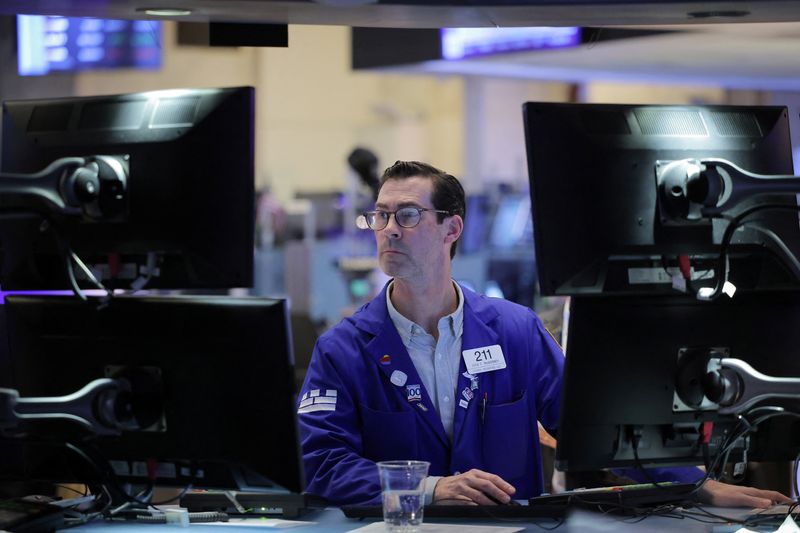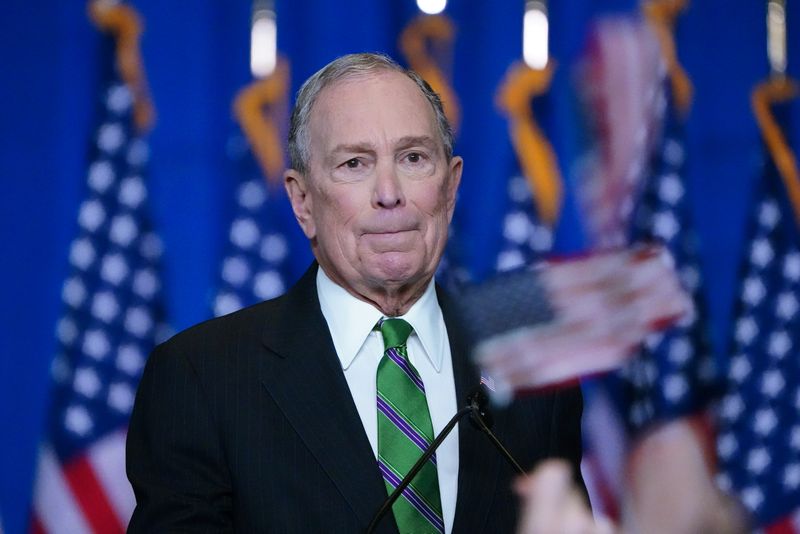Select Language

By Andrea Shalal, David Lawder, Karen Freifeld
WASHINGTON/NEW YORK(Reuters) -The United States on Friday issued draft rules for banning or requiring notification of certain investments in artificial intelligence and other technology sectors in China that could threaten U.S. national security.
The U.S. Treasury Department published the proposed rules and a raft of exceptions after an initial comment period following an executive order signed by President Joe Biden last August. The rules put the onus on U.S. individuals and companies to determine which transactions will be restricted or banned.
Biden's executive order, which directed regulation of certain U.S. investments in semiconductors and microelectronics, quantum computing and artificial intelligence, is part of a broader push to prevent U.S. know-how from helping the Chinese to develop sophisticated technology and dominate global markets.
The U.S. is on track to implement regulations by the end of the year as anticipated. Public comments on the proposed rules will be accepted until Aug. 4.
"This proposed rule advances our national security by preventing the many benefits certain U.S. investments provide - beyond just capital - from supporting the development of sensitive technologies in countries that may use them to threaten our national security,” said Treasury Assistant Secretary for Investment Security Paul Rosen.
Treasury said the new rules were intended to implement "a narrow and targeted national security program" focused on certain outbound investments in countries of concern.
Treasury had mapped out the contours of the proposed rules in August. The Treasury Department on Friday included additional exceptions, such as for transactions deemed to be in the U.S. national interest.

Investing.com -- For investors trying to assess how soon interest rate moves are likely to come a closely watched U.S. inflation gauge along with preliminary June inflation data from some euro zone economies will be in the spotlight this week. Concerns over signs of big tech exhaustion plus escalating trade tensions are also in focus. Here’s your look at what's happening in markets for the week ahead.
US inflation
The Fed’s favoured inflation gauge, the personal consumption expenditures price index is due for release on Friday and should show whether a nascent slowdown in inflation is continuing.
But recent PCE readings have not been in line with expectations. The latest reading showed U.S. inflation unexpectedly tracking sideways in April.
Another such reading could undermine the argument that rate cuts are coming soon. Unlike the Fed, markets are still holding out for two rate cuts this year.
The economic calendar also includes June data on consumer confidence along with May data on both new and existing home sales. There is also a third estimate of first-quarter economic growth, plus data on durable goods orders for May.
Tech rally may be overheating
Many investors believe the long-term case for tech stocks is solid, given their strong earnings and excitement over the revolutionary potential of artificial intelligence. But huge price gains, including Nvidia (NASDAQ:NVDA)'s 155% year-to-date run, have stirred worries that the tech rally might be getting stretched.
Market laggards such as small caps and so-called value stocks such financials and industrials may be looking like bargains.
But even if a pullback does occur, there are few signs’ investors would leave tech and growth stocks for long. Betting against tech has been a losing proposition over the last decade, as the Nasdaq 100 index has advanced more than 400% while the Russell 1000 Value is up about 70% over the same time.
Tech could also rebound fairly quickly as investors rush to buy the dip.
Oil prices
Oil prices eased about 1% on Friday on worries that global oil demand growth could be hit by a strong U.S. dollar and negative economic news from some parts of the world.
For the week, both crude benchmarks were up about 3% after gaining about 4% the previous week.
The U.S. dollar rose to a seven-week high versus a basket of other currencies Friday with the Federal Reserve's patient approach to cutting interest rates contrasting with more dovish stances elsewhere.
Lower rates could support oil prices, which have been dragged this year by lackluster global demand. A U.S. rate cut would make borrowing cheaper in the world's largest economy, galvanizing the appetite for oil as production picks up.
In the week ahead oil prices are also likely to remain supported by growing geopolitical risk premium.
Eurozone inflation
In the euro zone, France, Italy and Spain are to release preliminary June inflation data on Friday.
The data will set the tone for a euro zone-wide print the following week, key for traders trying to gauge how many times the European Central Bank will cut rates this year.
The ECB cut rates on June 6, but still strong domestic inflation and wages have raised question marks on how many more will follow.
Traders expect one more cut and a roughly 64% chance of a second by year-end, down from nearly 80% before the June meeting.
Any upside surprise would sour the mood for investors grappling with fresh political uncertainty after French President Emmanuel Macron called a first round French election on June 30.
Trade tensions
China and the European Union have agreed to start talks on the planned imposition of tariffs on Chinese-made electric vehicles (EVs) being imported into the European market.
Earlier this month Brussels proposed hefty duties to combat what the European Union considers excessive subsidies. The EU's provisional duties of up to 38.1% on imported Chinese EVs are set to apply by July 4, before coming into full effect in November.
The European Commission's June 12 announcement followed a move by the United States to hike tariffs on Chinese cars in May and opens a new front in the West's trade war with Beijing.
Chinese authorities have hinted at possible retaliatory measures through state media commentaries and interviews with industry figures.
--Reuters contributed reporting

LONDON (Reuters) - British public debt rose last month to its highest as a share of the economy since 1961, official figures showed on Friday, adding to the financial pressures faced by the country's next government after an election on July 4.
Public sector net debt, excluding state-controlled banks, rose to 2.742 trillion pounds ($3.47 trillion) or 99.8% of gross domestic product in May, up from 96.1% a year earlier, the Office for National Statistics said.
The increase came despite slightly lower than expected government borrowing in May, which came in at 15.0 billion pounds, just below economists median forecast of 15.7 billion pounds in a Reuters poll.
Borrowing in the first two months of the financial year totalled 33.5 billion pounds, 0.4 billion more than during the same period in 2023.
Britain looks headed for a change of government following the election next month, as Keir Starmer's Labour Party is far ahead of Prime Minister Rishi Sunak's Conservatives in the polls.
Public debt soared in Britain during the COVID-19 pandemic, and the public finances have also been hit by slow growth and a rise in Bank of England interest rates to a 16-year high.
Both Labour and the Conservatives have pledged not to raise the rate of income tax, value-added tax or other major levies, but government budget forecasts in March showed tax as a share of GDP was on track to reach its highest since 1948.
($1 = 0.7897 pounds)
Labour and the Conservatives intend to stick with existing budget rules which require official forecasts to predict that debt as a share of GDP will fall between the fourth and fifth years of the forecast.
Labour has said it will aim to run a balanced budget for day-to-day spending, but will borrow for longer-term investment. The Conservatives aim to keep the overall deficit no higher than 3% of GDP.

By Rajendra Jadhav
(Reuters) - Food inflation in India, driven by supply-side factors like adverse weather affecting crops, has remained at around 8% year-on-year since November 2023 and is unlikely to ease any time soon, despite early arrival of monsoon rains and forecasts of above-normal rainfall.
Elevated prices of food, which accounts for nearly half of the overall consumer price basket, has kept headline inflation above the central bank's target of 4%, preventing it from cutting interest rates.
WHAT IS DRIVING FOOD INFLATION HIGHER?
A drought last year and an ongoing heat wave have significantly reduced the supplies of foods like pulses, vegetables, and cereals.
Curbs on food exports and reducing tariffs on imports have had little effect.
Although vegetable supplies generally decrease during the summer months, this year's decline is much more pronounced. Temperatures in nearly half of the country are soaring 4-9 degrees Celsius above normal, spoiling harvested and stored vegetables and hindering the planting of crops such as onions, tomatoes, eggplant and spinach.
Farmers usually prepare vegetable seedlings before the June-September monsoon rains and transplant them to the main fields afterward. However, this year, the excessive heat and water scarcity have disrupted both seedling planting and replanting, further exacerbating the shortage of vegetables.
WHY HAS THE MONSOON NOT HELPED?
The annual monsoon, on which India's agricultural output is dependent, arrived early in the southern tip of the country and advanced swiftly to cover the western state of Maharashtra ahead of schedule. However, this initial momentum soon waned, resulting in a 18% rainfall deficit so far this season.
Besides triggering the heat wave, the weakened monsoon has delayed the planting of summer-sown crops, which can only proceed at full pace with sufficient rainfall.
Despite June's patchy rains, India's weather office has forecast above average rainfall for the rest of the monsoon season.
WHEN WILL PRICES COME DOWN?
Vegetable prices are expected to fall from August onwards if the monsoon revives and covers the entire country as per the usual schedule. However, floods or a prolonged dry spell in July and August could disrupt the production cycle.
Prices of milk, cereals and pulses are unlikely to decrease soon due to tight supplies. Wheat supplies are dwindling, and the government has announced no plans to import grain, which will allow wheat prices to rise further.
Rice prices may increase as the government on Wednesday raised the minimum support price, or buying price, of paddy rice by 5.4%. Supplies of pulses, such as pigeon peas, black matpe and chickpeas, were severely affected by last year's drought, and will not improve until the new season crops are harvested.
Sugar prices are likely to remain high as next season's production is expected to fall due to lower planting.
CAN GOVERNMENT INTERVENTION HELP?
Yes, government interventions such as restricting exports and easing imports can help bring down the prices of some food commodities. However, the government can do little when it comes to prices of vegetables, which are highly perishable and difficult to import.
The government has implemented various measures to bring down food prices by restricting exports of sugar, rice, onions and wheat. However, these measures have proved unpopular among farmers, and led to losses in the general election for the ruling Bharatiya Janata Party in rural areas.
State elections are approaching in Maharashtra and Haryana, where a significant farmer population will decide the outcome. The central government has been trying to win back farmers' support and may allow prices of some crops to rise instead of taking aggressive measures before the elections, which are due in October.

TOKYO (Reuters) - Japan imposed trade restrictions on China-based companies as part of a fresh round of sanctions against individuals and groups supporting Russia's war on Ukraine, the foreign ministry said in a statement on Friday.
The new sanctions also target firms in India, Kazakhstan, and Uzbekistan. It marks the first time Japan has imposed sanctions on China-based firms in connection with the war in Ukraine, according to Japan's foreign ministry.
Targeted firms include Hong Kong-based Asia Pacific Links Ltd, which provided microchips for Russian drones, and China-based Yilufa Electronics Limited.
The sanctions, which are in line with previous measures imposed by other countries including the United States, forbid Japanese companies from exporting to the targeted firms.
U.S. officials have said China is backing Russia's war effort in Ukraine by providing drone and missile technology for Moscow's biggest military buildup since the Soviet era.
The U.S. broadened its sanctions on Russia last week, including by targeting China-based companies selling semiconductors to Moscow.
Beijing and Moscow are also taking complex steps to ensure bilateral payments are made, potentially exposing some Chinese financial firms to sanctions.

By Cynthia Kim
SEOUL (Reuters) - South Korea's foreign exchange authorities on Friday said they agreed with the National Pension Service to expand a currency swap line to $50 billion from the current $35 billion to defend the tumbling won against the dollar.
"The foreign exchange authorities believe that the FX swap with the National Pension Service can work to alleviate the supply-demand imbalance in the foreign exchange market by absorbing the National Pension Service's spot dollar purchase demand when the currency market is unstable," the finance ministry said in a statement.
The move is seen as an indirect intervention into the spot dollar-won market because the swap line allows the fund to borrow from the central bank's foreign exchange reserves instead of buying dollars in the onshore currency market.
The won slid to 1,393.0 per dollar early on Friday, the weakest level since April 16 and nearing a key resistance level of 1,400 closely watched by the market participants.

By Nandita Bose and Kanishka Singh
WASHINGTON (Reuters) - Billionaire Mike Bloomberg has given nearly $20 million to help Democratic President Joe Biden's re-election effort against Republican former President Donald Trump, two sources familiar with the matter told Reuters on Thursday.
Bloomberg's contribution included $19 million to an independent pro-Biden group known as Future Forward or FF PAC, and over $900,000 to the Biden Victory Fund, which is an amalgamation of the Biden campaign and Democratic Party committees, the sources added, asking not to be identified.
The donations were first reported by the Washington Post. The Biden campaign did not immediately respond to a request for comment.
Bloomberg, the former New York mayor who spent $1 billion of his own money on a failed 2020 presidential bid in the Democratic primaries, injected at least $100 million to help Biden's campaign against Trump in Florida in 2020. Trump, who lost the overall 2020 race to Biden, had won in Florida by over three percentage points.
Biden and Trump have mostly been tied in national polls.
Democrats have maintained an overall cash advantage over Trump and the Biden campaign continues to have a considerably larger war chest. Biden's campaign reported $84 million in the bank at the end of April, compared to $49 million reported by Trump.
However, Biden campaign's fundraising in April lagged Trump's for the first time, after the former president ramped up his joint operation with the Republican National Committee and headlined high-dollar fundraisers.
Pro-Trump spending groups have spent more than $25 million since Trump clinched the Republican nomination on March 6, Federal Election Commission records show, compared to more than $15 million spent by Biden's allies during the same time.

By David Milliken
LONDON (Reuters) - Britain's central bank looks on course to hold interest rates at a 16-year high of 5.25% on Thursday as underlying inflation pressures prove persistent, depriving Prime Minister Rishi Sunak of a much-needed boost ahead of a July 4 election.
Bank of England Governor Andrew Bailey opened the door early last month to a rate cut, saying he was "optimistic that things are moving in the right direction" and that a June rate cut was an option - although no fait accompli.
But despite data on Wednesday showing headline inflation fell back to the BoE's 2% target for the first time in nearly three years in May - reaching its goal quicker than in the United States or euro zone - the medium-term picture is now less reassuring.
Services price inflation has fallen less than the BoE expected at the time of the last meeting - only declining to 5.7% rather than 5.3% - and private-sector wage growth is almost twice the rate the BoE judges as compatible with 2% inflation.
Last month the central bank forecast inflation would rise to around 2.6% by the end of the year, as the effect of recent cuts to regulated household energy bills faded.
None of the 65 economists in a Reuters poll last week said they expected the BoE to follow the lead of the European Central Bank and cut rates this month, with the next statement on Aug. 1 looking by far the most probable start date for an easing cycle.
Instead, the expectation is for a repeat of May's 7-2 vote split, when Deputy Governor Dave Ramsden and external Monetary Policy Committee member Swati Dhingra voted for a quarter-point cut.
"We think the Bank of England is left waiting for more reassuring data ... either in the shape of a more decisive moderation in services CPI or with all other broader signals ... pointing in a softer direction," Victoria Clarke, chief UK economist at Santander (BME:SAN), said.
While unemployment is at a two-and-a-half year high of 4.4%, economic growth this year has been reasonable by Britain's recent weak standards.
Financial markets are doubtful about an August rate cut. On Wednesday they priced in only a 30% chance, with a first move more likely in September and a risk of a delay until November, similar to expectations for the U.S. Federal Reserve.
Either way, any cut is likely to be too late for Sunak, whose Conservative Party is around 20 points behind the opposition Labour Party in the pre-election polls.
While Sunak has sought credit for the fall in inflation since he took office in October 2022, when it was at a 41-year high of 11.1%, Labour blames high mortgage rates on economic mismanagement by the Conservatives' previous leader, Liz Truss.
Since the start of the election campaign the BoE has been in a self-imposed period of silence, cancelling public events.
Before that, BoE Chief Economist Huw Pill had described an excessive focus on a June rate cut as "ill advised" but both he and Deputy Governor Ben Broadbent - who steps down at the end of this month - said a rate cut over the summer was possible.
The BoE began to raise rates in December 2021, earlier than other major central banks, and they reached their current peak in August 2023.

By Ankur Banerjee
SINGAPORE (Reuters) -Asian stocks took a breather on Thursday, hovering near their highest in two years as traders waited for more U.S. policy clues, while sterling was steady before a Bank of England meeting where rates are expected to remain unchanged.
Apart from the BoE, investors will also watch for central bank decisions from Switzerland and Norway on Thursday to set the tone for a global rates outlook.
MSCI's broadest index of Asia-Pacific shares outside Japan was little changed at 572.42, just below the two-year high of 573.38 it touched on Wednesday boosted by tech stocks. The index is on course for a 4% rise in June.
European stock markets were due for a higher open, with Eurostoxx 50 futures and FTSE futures0.2% higher ahead of the slew of central bank decisions.
The pound was steady at $1.27125 in cautious trading but is down 0.2% in June. [FRX/]
Data on Wednesday showed British inflation returned to its 2% target for the first time in nearly three years in May, but strong underlying price pressures all but rule out an interest rate cut ahead of election next month.
Most economists in a Reuters poll last week thought the central bank would start to cut rates in August, but markets see only a 30% chance of an August rate cut and think a first move is more likely in September or November.
Markets have priced in 43 basis points of easing from BoE this year.
The Swiss National Bank on the other hand is widely expected to cut its key policy rate by 25 basis points for a second straight meeting. Norway's central bank is likely to keep its key policy interest rate unchanged.
In Asia, Japan's Nikkeiwas 0.10% higher, while stocks in China and Hong Kong fell, weighed down by lacklustre property shares, as Beijing left its key benchmark lending rates unchanged despite recent data showing the economy remains wobbly.
The onshore yuanweakened past 7.26 per dollar for the first time since November.
The dollar index, which measures the U.S. unit against six rivals, was little changed at 105.27, while the euro was steady at $1.0746.
A surge in tech stocks on Tuesday lifted AI chipmaker Nvidia (NASDAQ:NVDA) above Microsoft (NASDAQ:MSFT) as the world's most valuable company, leading to a global rally in tech shares.
U.S. markets were closed on Wednesday, with tech heavy Nasdaq futures up 0.5% on Thursday.
The frenzy over artificial intelligence has resulted in technology stocks roaring through the year, with Nvidia leading the pack along with select few behemoths as U.S. stocks clock record highs and also boost Asian counterparts.
"Nvidia remains the most important stock in the world," Chris Weston, head of research at Pepperstone, said in a note.
Weston though cautioned that index market breadth has been poor, with participation underwhelming, suggesting the rally has been built on a shaky foundation.
"The fact remains the market is now all in on the rally in AI-related names and big tech and given the lack of clear immediate risk the path of least resistance is for higher equity index levels."
On a macro level, investors are looking for fresh cues as to when the Federal Reserve would start its policy easing cycle after the central bank last week projected just one rate cut in the year and policymakers this week have also been cautious.
The Japanese yen languished at 158.17 per dollar as the wide difference in the interest rates between Japan and the United States weigh on the currency. The yen is down over 10% against the dollar this year. "I think the best-case scenario is September Fed interest rate cut that narrows the yield differential between dollar and yen", according to Stefan Hofer, chief investment strategist, LGT Bank Asia.
In commodities, oil prices were mixed, with Brentsteady at $85.12 per barrel, while U.S. West Texas Intermediate crude for June was 0.23% lower at $81.38 per barrel. [O/R]

By Vivek Mishra and Hari Kishan
BENGALURU (Reuters) - The Indian economy is likely to remain the fastest-growing major one in coming years, but a majority of independent economists and policy experts polled by Reuters are not confident it will make any difference in narrowing stark economic inequality.
Despite over 8% economic growth last fiscal year and a roaring stock market in Mumbai that is easily one of the world's most expensive, New Delhi still distributes free food grains to more than 800 million of its 1.4 billion people.
Prime Minister Narendra Modi, sworn in for a third term with the support of regional parties after a shock election where his Bharatiya Janata Party lost its sizeable majority in parliament, has retained most ministers from his second one.
Yet rising economic inequality - around its highest in decades - and high youth unemployment were widely reported as reasons for the electoral drubbing after securing sweeping victories in 2014 and 2019 on development and economic reform platforms.
A nearly 85% majority of development economists and policy experts, 43 out of 51, in a May 15-June 18 Reuters poll, said they were not confident economic inequality would significantly reduce over the next five years, including 21 who said they had no confidence at all.
Only six said they were confident and two said very confident. These are separate from private economists who regularly forecast economic data and interest rates.
"Acknowledging that it is a problem will be a good first step ... Currently, reduction of economic inequality is not a policy objective of decision-makers," said Reetika Khera, a development economist at the Indian Institute of Technology in New Delhi.
"Inequality is not something that will go away on its own ... it needs proactive government interventions."
Even for a developing economy, income inequality in India is too extreme, according to a March report from the World Inequality Lab.
However, not everyone agrees.
"I don't think the inequality metrics are meaningful for India. The key issue is not inequality but how the bottom of the pyramid fares economically. This is not a function of how the top does," said Nagpurnanand Prabhala, finance professor at Johns Hopkins University.
India has the second-highest number of billionaires in Asia but has tens of millions who depend on the government's 100 days minimum guaranteed wage employment programme, digging wells, building roads, and filling potholes for about $4 a day.
"The present government has created an economic system that shrunk the middle-income group considerably. The poor are on public dole ... the rich are on public cross-subsidy using crony capitalism," said Saibal Kar, professor of industrial economics at the Center for Studies in Social Sciences.
"The economic and social freedoms are low owing to repressive public policies. This has to change. Unless it changes, inequality will rise further."
SKILLS NEEDED, NOT JUST JOBS
Asked to rate the quality of India's economic growth over the past 10 years, a near-80% majority of economists surveyed, 42 of 53, said it was not inclusive, with 17 saying not at all. Eight said fairly inclusive and three said inclusive.
And yet 60%, 32 of 53, said India would maintain or exceed the current solid GDP growth rate over the next five years. The rest said it will fall short.
While the Modi government has set a target of turning India into a developed economy by 2047, several experts in the survey said the government should first improve workers' skills, create more jobs and focus on inclusive growth.
In December, the government's chief economic adviser said the subsidised grain distribution, as well as spending on education and health had helped to distribute income more equally.
During the election campaign, a government document showed Modi wanted to focus on 70 areas of improvement including workforce skills and vocational training.
Over 90% of experts polled, 49 of 54, who answered a separate question said unemployment would be the biggest economic challenge for the government over the next five years.
The unemployment rate was at 7.0% in May, according to the Center for Monitoring Indian Economy, a think-tank, up from around 6% before the pandemic.
"Most countries that have experienced more rapid growth did it on the basis of a farm-to-factory structural transformation," said Parikshit Ghosh, professor at the Delhi School of Economics, adding manufacturing as a share of GDP has hovered around 15% for about 30 years.
"Of the multiple factors behind this, perhaps the most important is the failure to invest seriously in education."
India spends around 3% of GDP on public education, half the 6% the government's National Policy on Education recommends.
Other experts pointed out the ongoing challenges presented by a society still mired in caste and class divisions.
"We don't even talk about the cleavage that has been ripping our society apart for thousands of years now in our living rooms - we still live in a world where Dalit families are cleaning toilets in urban and rural areas, generation after generation," said Aditi Bhowmick, a public policy expert, who previously worked as India Director at Development Data Lab.
(See a separate poll story on unemployment in India)
(Polling by Vivek Mishra, Pranoy Krishna, Devayani Sathyan, Purujit Arun, Anant Chandak, Veronica Khongwir, Milounee Purohit; Editing by Ross Finley and Alison Williams)

